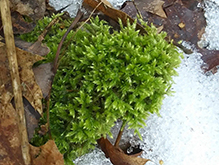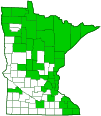tree climacium moss
(Climacium dendroides)
Conservation • Description • Habitat • Ecology • Use • Distribution • Taxonomy
|
|
||||||||||||||
Description |
Tree climacium moss is a large, carpet-forming (pleurocarpous), feather moss. It occurs in Europe, Asia, and North America, where it is native. It also occurs in New Zealand, where it was probably introduced. In the United States, it occurs from Maine to South Carolina, west to Washington and New Mexico. It is common in Minnesota. Tree climacium moss grows on the ground or on logs, rarely on rocks. It grows in moist or wet areas, especially areas subject to periodic fluctuations of water. It is found in rich woodlands, marshes, swamps, fens, the edges of peatlands, the edges of lakes, damp grasslands, and dune slacks. It is usually found in a loose tuft of numerous plants, but it sometimes grows alone. When young, each plant in the tuft looks distinctly tree-like. When mature, the upper branches intertwine with adjacent plants, making it difficult to pick out an individual plant. The primary stem is creeping, rhizome-like, and it lies flat on the ground (prostrate). It is mostly leafless, and it is densely covered with loose, woolly, reddish-brown filaments (rhizoids) that anchor it to the ground. The plant’s growth form is sympodial. Two branches are formed at the end of the primary stem. One branch lies flat on the ground and becomes a continuation of the primary stem. The second branch becomes the secondary (aerial) stem. The aerial stem is erect, reddish brown, robust, and ¾″ to 3⅛″ (2 to 8 cm) tall. It has tree-like branching, with numerous crowded branches at the top of the stem and no branches below. It appears to be naked, but it has appressed, scale-like leaves. The stem leaves are egg shaped and broadly angled at the tip. There is sometimes an abrupt, sharp point at the tip. They may have ear-like expansions (auricles) at the base or be only slightly expanded at the base. The branch leaves are narrowly egg shaped, 1⁄16″to ⅛″ (2 to 3 mm) long, and dark green to yellowish. They have a single prominent midrib. They are folded or pleated longitudinally near the end. The tip is broadly angled and has an abrupt, sharp point. Branch leaves are spreading when they are wet, but they are tightly appressed when they are dry. Tiny, green, photosynthetic filaments (paraphyllia) are borne between the leaves, but it requires a 20x hand lens to see them. Male plants are much more common than female plants, and reproductive structures (capsules) are rarely produced. When present, the capsules are erect, reddish orange to reddish brown, shortly oblong cylinder shaped, symmetric, and 1⁄16″ to ⅛″ (1.5 to 3 mm) long or longer. They mature in the fall. |
Growth Form |
Pleurocarp |
Height |
¾″ to 3⅛″ (2 to 8 cm) |
Similar Species |
Habitat |
Rrich woodlands, marshes, swamps, fens, the edges of peatlands, the edges of lakes, damp grasslands, and dune slacks |
Ecology |
Phenology |
Capsules mature in the fall. |
Use |
|
Distribution |
||
|
Sources Janssens, J.A. 2014. Noteworthy Mosses & Liverworts of Minnesota, Part II: Species Fact Sheets. Minnesota Department of Natural Resources 2014, 208 pp. |
|
| 2/19/2024 | ||
Nativity |
||
Native |
||
Occurrence |
||
Common and widespread |
||
Taxonomy |
|
Kingdom |
|
Division |
|
Subdivision |
Bryophytina (Moss) |
Class |
Bryopsida (Joint-toothed Mosses) |
Subclass |
Bryidae |
Order |
Hypnales (Feather Mosses) |
Family |
Climaciaceae (climacium moss) |
Genus |
Climacium (climacium mosses) |
Subordinate Taxa |
|
At least eleven varieties of this species have been described, but none of them are currently recognized. |
|
Synonyms |
|
Amblystegium solitarium Calliergon solitarium Climacium epigaeum Climacium europaeanum Climacium novae-seelandiae Hypnum dendroides Hypnum dendroides var. europaeum Hypnum solitarium Leskea dendroides Neckera dendroides |
|
Common Names |
|
common tree moss European tree moss tree climacium moss tree moss |
|
Glossary
Auricle
A small, ear-like projection at the base of a leaf or at the junction of a grass blade and stem.
Prostrate
Laying flat on the ground.
Rhizoid
A filament arising from the lower stem of a moss, liverwort, or alga that anchors it to a substrate.
Visitor Photos |
||
Share your photo of this plant. |
||
This button not working for you? |
||
Luciearl |
||
 |
|
|
MinnesotaSeasons.com Photos |
||
|
||
|
||

Slideshows |
CLIMACIACEAE |
 |
About
Climacium dendroides |

Visitor Videos |
||
Share your video of this plant. |
||
This button not working for you? |
||
|
Other Videos |
||
The tree ladder moss or tree-like palm moss (Climacium dendroides) |
About
Apr 5, 2023 The tree ladder moss or tree-like palm moss (Climacium dendroides) is a deciduous moss common in Central Europe, which always occurs in very damp places. |

|
Created: 2/20/2024 Last Updated: © MinnesotaSeasons.com. All rights reserved. |



